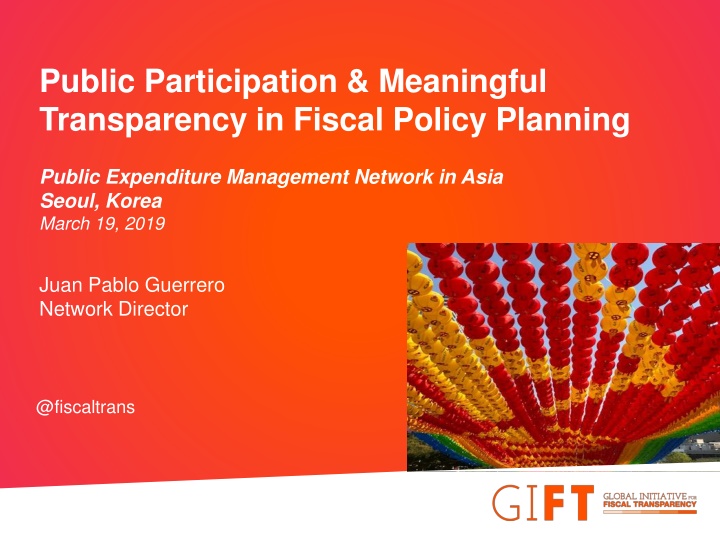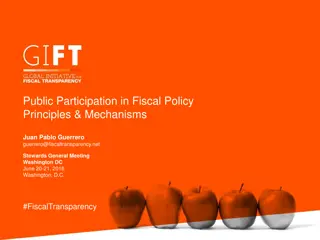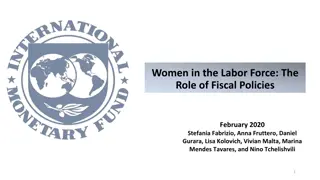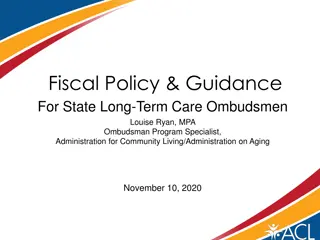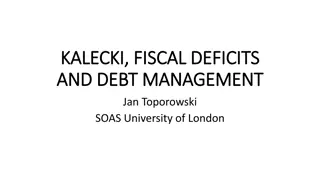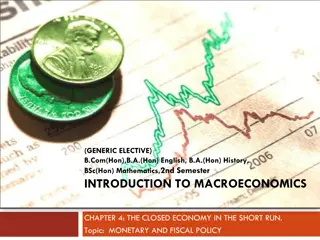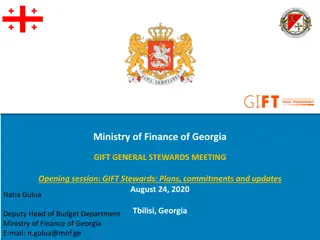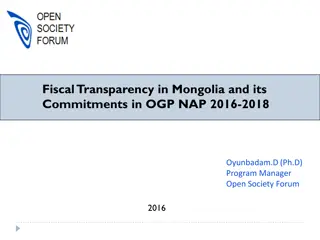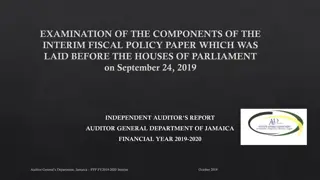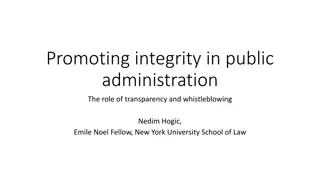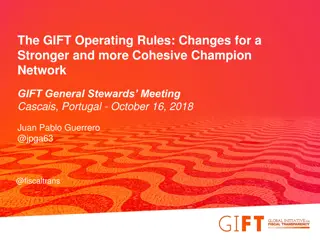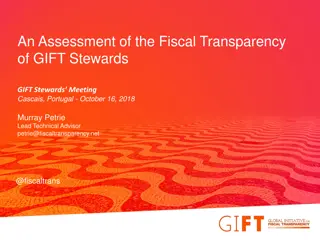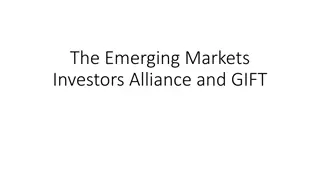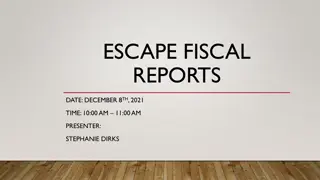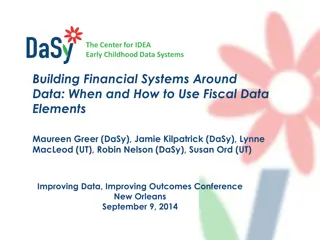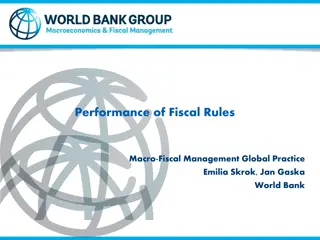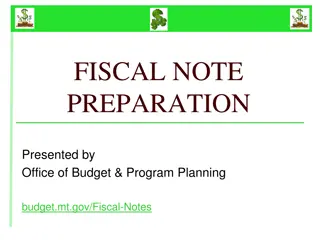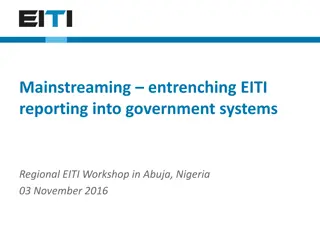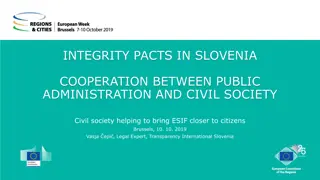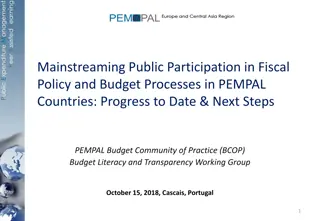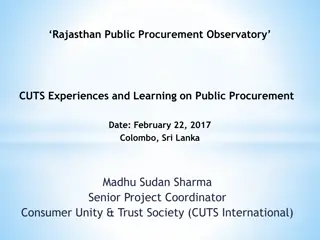Enhancing Fiscal Policy Planning through Public Participation and Transparency
Explore the importance of public participation and meaningful transparency in fiscal policy planning and public expenditure management. Learn about the GIFT Network, its champions and stewards, and how fiscal transparency and public participation can lead to improved fiscal and development outcomes by fostering accountability, efficiency, and sustainability.
Download Presentation

Please find below an Image/Link to download the presentation.
The content on the website is provided AS IS for your information and personal use only. It may not be sold, licensed, or shared on other websites without obtaining consent from the author.If you encounter any issues during the download, it is possible that the publisher has removed the file from their server.
You are allowed to download the files provided on this website for personal or commercial use, subject to the condition that they are used lawfully. All files are the property of their respective owners.
The content on the website is provided AS IS for your information and personal use only. It may not be sold, licensed, or shared on other websites without obtaining consent from the author.
E N D
Presentation Transcript
Public Participation & Meaningful Transparency in Fiscal Policy Planning Public Expenditure Management Network in Asia Seoul, Korea March 19, 2019 Juan Pablo Guerrero Network Director @fiscaltrans
GIFT Network Presentation: Outline The GIFT network Why Public Participation has become part of PFM Governance? Public Participation in Fiscal Policies: Principles, Practices and Impact 2
GIFT Stewards - The 48 Champions WBG, IMF, OECD IFAC, MITRE, OCP CABRI, IPF, Global Integrity, PEFA Brazil (Budget Sec) Philippines (DBM) Mexico (SHCP) + 16 budget Government agencies Intl Orgs/ Networks (10) Government (19) Funders/ Foundations (4) Civil Society Organization (15) Hewlett F. IBP, Fundar, ILDA, CBPP, INESC, Icefi, ACIJ, Obs-Fiscal, Seknas Funde, PSAM, Emerging M., NCDHR, Social Watch, (Fund. Solidaridad) Omidyar Ford F. DfID 3
Budget Authorities - Stewards of GIFT 1. Federal Secretary of Budget and Planning of Brazil 2. Department of Budget and Management of the Philippines 3. The US Treasury Department 4. Ministry of Finance, Mexico 5. Budget Department of the National Treasury, South Africa 6. Technical Secretariat of Planning & Economic & Social Development, Paraguay 7. Ministry of Finance, Indonesia 8. Ministry of Finance, El Salvador 9. Ministry of Finance, The Dominican Republic 10. Ministry of Economy & Finance, Tunisia 11. Ministry of Finance, Guatemala 12. Office of the Budget & Planning, Uruguay 13. Ministry of Finance, Croatia 14. Ministry of Budget and National Planning, Nigeria 15. Budget Directorate of the Ministry of the Treasury, Chile 16. Ministry of Finance, Ukraine 17. Ministry of Economy & Finance, Benin 18. Secretariat of the Budget of the Ministry of the Treasury, Argentina 19. Directorate of the National Budget, Ministry of the Treasury, Colombia + Working closely with partners: Slovenia, Egypt, Liberia, Senegal, Ireland, Scotland
The bodies of GIFT Community of Practice Partners Stewards Lead Stewards GIFT Coordination Team 5
Fiscal Transparency (FT) + Public Participation (PP) lead to better fiscal and development outcomes Improved fiscal outcomes fairer, more efficient & effective taxation & public services, more legitimate & sustainable fiscal performance Fiscal Public participation Improved social, economic and environmental outcomes e.g. Improvement in SDG indicators Accountability transparency Public disclosure of high quality fiscal data & information in budgets, forecasts, outturns etc Direct Public officials held effectively to account for stewardship of public resources engagement by the public in fiscal policy design & implementation 6
Why public participation in the budget cycle? 2008: Global Financial Crisis, PFM Governance, disclosure of information alone is not sufficient for accountability Participation is key for Sustainable Development Goals: 1- poverty, 5-gender equality, 10-reduce inequality, 16-peace, justice & inclusive institutions Public Participation as a the core of Open Government Partnership Government data at reach: big data, open data & digital technologies 7
GIFT history reflects PP in FT International Standards 2012: GIFT High-Level Principles on FTAP & UN General Assembly acknowledgement 12: IBP-OBS leads the way, with section on PP 2014: IMF revision of Fiscal Transparency Code 2015: OECD Principles on Budgetary Governance 15: Tax Administration Diagnostic Assessment Tool-TADAT 15: Open Contracting Partnership- OCP 15: GIFT Principles on PP and Guide on practices 2016: Revised PEFA Indicator Program 16: Extractive Industries Transparency Initiative- EITI 2017: New PP section in OBS-IBP 17: OECD Budget Transparency Toolkit 17: PEMPAL network engages systematically on topic 2018: IMF Fiscal Transparency Handbook 2019: IBP/GIFT PP pilots 8
How Do CSOs Use Budget Information? (De Renzio-Mastruzzi 2016) - Mismatch between Government efforts & CSO needs - Aggregate budget information is available, BUT Agency/facility level data, performance, off budget is much less available - Need for information linked to service delivery & population needs: linking budget with outcomes - Quality is a big issue: comprehensiveness, accessibility, timeliness and usability 9
Missing: Budget Data on Public Service Delivery 1. The length and complexity of the funding chain + the different data sets involved 2. Budgets and fiscal reports show spending by ministry, citizens cannot see the budgets or performance information down to their local service delivery units 3. Lack of transparency of spending of individual service delivery units e.g. schools, hospitals 10
Accessibility Depth / Relevance Openness Proportionality Inclusiveness Sustainability Respect for self- expression Complementarity Reciprocity Timeliness 11
Core considerations 1. Publish information accessibly + meaningfully (address demand) 2. Clarity on the rules of engagement in order to ensure clear expectations 3. Add value & relevance to the process: inform well, on time, get feedback (speak to users), try to institutionalize, ensure a fair engagement 4. Reach out to those usually quiet (INCLUSION) 5. Seek that public participation complement what government institutions do
PP mechanisms across the budget cycle - SAI engagement on audit planning, and conduct of performance audits (budget monitor) - Legislative consultation on departmental reviews - Social audits of revenues +expenditures - Pre-budget hearings / consultations / submissions - Public Councils - Tax policy reviews & consultations - Bottom-Up consultations - Online mechanisms Executive Budget Preparation Audit and oversight Legislative approval Budget Implementation - Consultation on Policy Statement, and annual proposal - Public hearings +Submissions on money Bills - Independent Fiscal Institutions - Complaint mechanisms & feedback - Bottom Up budgeting / Participatory Budgeting - Citizen engaging & monitoring online 14
Online tools in the Public participation spectrum EXAMPLE Tools Inform Consult Involve Collaborate Empower -Multiple audiences -Multiple tools -Multiple objectives -Newsletter -Email -Video -Website -Social Media -Live Stream meetings -Social media discussions -Polls -Blogs -Workbook Surveys -Ideation -Surveys -Polls -Serious games -Social media discussions -Online fora -Document co- creation -Mapping -Twitter chat -Video meetings -Decision making: Online voting Participatory budgeting -Community actions (discussion fora) 15
1. Policy Objectives of Public Participation Better resource allocation (e.g. subnational transfers in Mexico, with the role of the media and CSOs leading to changes in the criteria for investment projects approval to observe urban sustainable mobility) Improvement in the provision of public services (e.g. social accountability / monitoring experiences of sanitation in South Africa or social audits in India) Better response to the preferences of beneficiaries of services (i.e. Kenya devolution experiences and refining gender subsidies beneficiaries in Mexico) 16
2. Public participation for what? Opportunity for marginalized groups to exert some influence in decisions that affect them (i.e. i-monitor in Nigeria which invites citizens to report budget waste, South Korea open consultations for budget implementation and in Indonesia, LAPOR, complaints on-line systems) Greater impact of social policies in development sectors: health sector, education, community level public works, etc. (participatory budgeting and social audits) Increases trust & citizen compliance (participatory budgeting) 17
1. Examples of PP mechanisms in the 2017 Open Budget Survey (Executive) Pre-budget hearings: usually open to all unless the mechanism is ad-hoc (Kyrgyz Rep., Malawi, Fiji, Ukraine, Sierra Leone, Benin) Pre-budget consultations: by invitation w/ key stakeholders (India, Bangladesh, Malaysia, Botswana, Liberia, Mali, Benin, Nigeria, Guatemala, Ireland) Pre-budget submissions: MoF invites to submit proposals; can be open to all, but not always feedback mechanisms (Canada, Australia, Tanzania, Ghana, South Africa, Zambia tax-, DRC, Tanzania tax-) 18
2. Examples of PP mechanisms in OBS 2017 (Executive) Public councils: elected representatives from civil society; some councils include reviewing policies & draft bills that feed into the budget, including investment projects or service delivery (Kyrgyz Rep., Kazakhstan, Georgia, Croatia, Bulgaria, Japan, Brazil) Policy consultations on specific issues: issues that may or may not affect the annual national budget (Moldova tax, Croatia, Czech Republic, UK, Ghana) Sector Working groups: convened for budget preparation; MoF + agencies & stakeholders discuss sector and cross- sector planning and prioritization (Kazakhstan, Russia, Kenya) 19
3. Examples of PP mechanisms in OBS 2017 (Executive) Online reporting mechanism: websites to provide a platform for registering complaints/ provide feedback/ report waste/ respond to surveys (S-Korea, Malaysia, Indonesia, Mexico) Bottom up consultations approach: consultations at the local level are used to inform agency budget proposals, subsequently submitted to the MoF (Philippines, Indonesia, Botswana) Participatory budgeting mechanisms: community members directly decide how to spend part of a budget, enabling taxpayers to make the budget decisions that affect them (Philippines, Mexico, Portugal, South Korea) 20
Main Takeaways . PFM governance frameworks now put citizens at the center of reforms Information disclosure that responds to needs of users & engaging the public on public services are growing practices around the world Use of digital tools provides opportunity to reach a much broader audience, playing a potentially crucial role in tackling trust deficits and in supporting better outcomes 21
Stay tuned! @fiscaltrans @fiscaltransparency @fiscaltransparency www.fiscaltransparency.net
